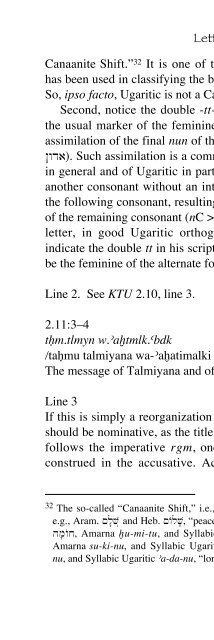A Primer on Ugaritic: Language, Culture, and Literature - enenuru
A Primer on Ugaritic: Language, Culture, and Literature - enenuru
A Primer on Ugaritic: Language, Culture, and Literature - enenuru
You also want an ePaper? Increase the reach of your titles
YUMPU automatically turns print PDFs into web optimized ePapers that Google loves.
Letters 71<br />
Canaanite Shift.” 32 It is <strong>on</strong>e of the important characteristics that<br />
has been used in classifying the branches of the Semitic languages.<br />
So, ipso facto, <strong>Ugaritic</strong> is not a Canaanite language.<br />
Sec<strong>on</strong>d, notice the double -tt- in /}adaœttiniyaœ/. The sec<strong>on</strong>d t is<br />
the usual marker of the feminine gender. The first t comes from<br />
assimilati<strong>on</strong> of the final nun of the word, }adn, “lord” (cp. Hebrew<br />
Nwda). Such assimilati<strong>on</strong> is a comm<strong>on</strong> feature of Semitic languages<br />
in general <strong>and</strong> of <strong>Ugaritic</strong> in particular. When n directly precedes<br />
another c<strong>on</strong>s<strong>on</strong>ant without an intervening vowel, it assimilates to<br />
the following c<strong>on</strong>s<strong>on</strong>ant, resulting in the doubling, or lengthening,<br />
of the remaining c<strong>on</strong>s<strong>on</strong>ant (nC >CC). Of course, the scribe of this<br />
letter, in good <strong>Ugaritic</strong> orthographic style, did not explicitly<br />
indicate the double tt in his script. Alternatively, this could simply<br />
be the feminine of the alternate form }ad, “lord.”<br />
Line 2. See KTU 2.10, line 3.<br />
2.11:3–4<br />
thm.tlmyn w.}ah˙tmlk.{bdk<br />
/tahmu talmiyana wa-}ah˙atimalki {abdeœki /<br />
The message of Talmiyana <strong>and</strong> of Ah˙ati-malki, your two servants.<br />
Line 3<br />
If this is simply a reorganizati<strong>on</strong> of the Type II heading, then thm<br />
should be nominative, as the title of the letter. However, since thm<br />
follows the imperative rgm, <strong>on</strong>e may argue that thm should be<br />
c<strong>on</strong>strued in the accusative. According to the evidence of the<br />
32 The so-called “Canaanite Shift,” i.e., aœ >oœ, has not taken place in <strong>Ugaritic</strong>;<br />
e.g., Aram. MDlv <strong>and</strong> Heb. MOwlDv, “peace”; Heb. rOwa <strong>and</strong> Ugar. }ar, “light”; Heb.<br />
hDmOwj, Amarna h˙u-mi-tu, <strong>and</strong> Syllabic <strong>Ugaritic</strong> h˙a-mi-ti, “wall”; Heb. NEkOws,<br />
Amarna su-ki-nu, <strong>and</strong> Syllabic <strong>Ugaritic</strong> sa-ki-nu, “governor”; Amarna a-dunu,<br />
<strong>and</strong> Syllabic <strong>Ugaritic</strong> }a-da-nu, “lord.”


